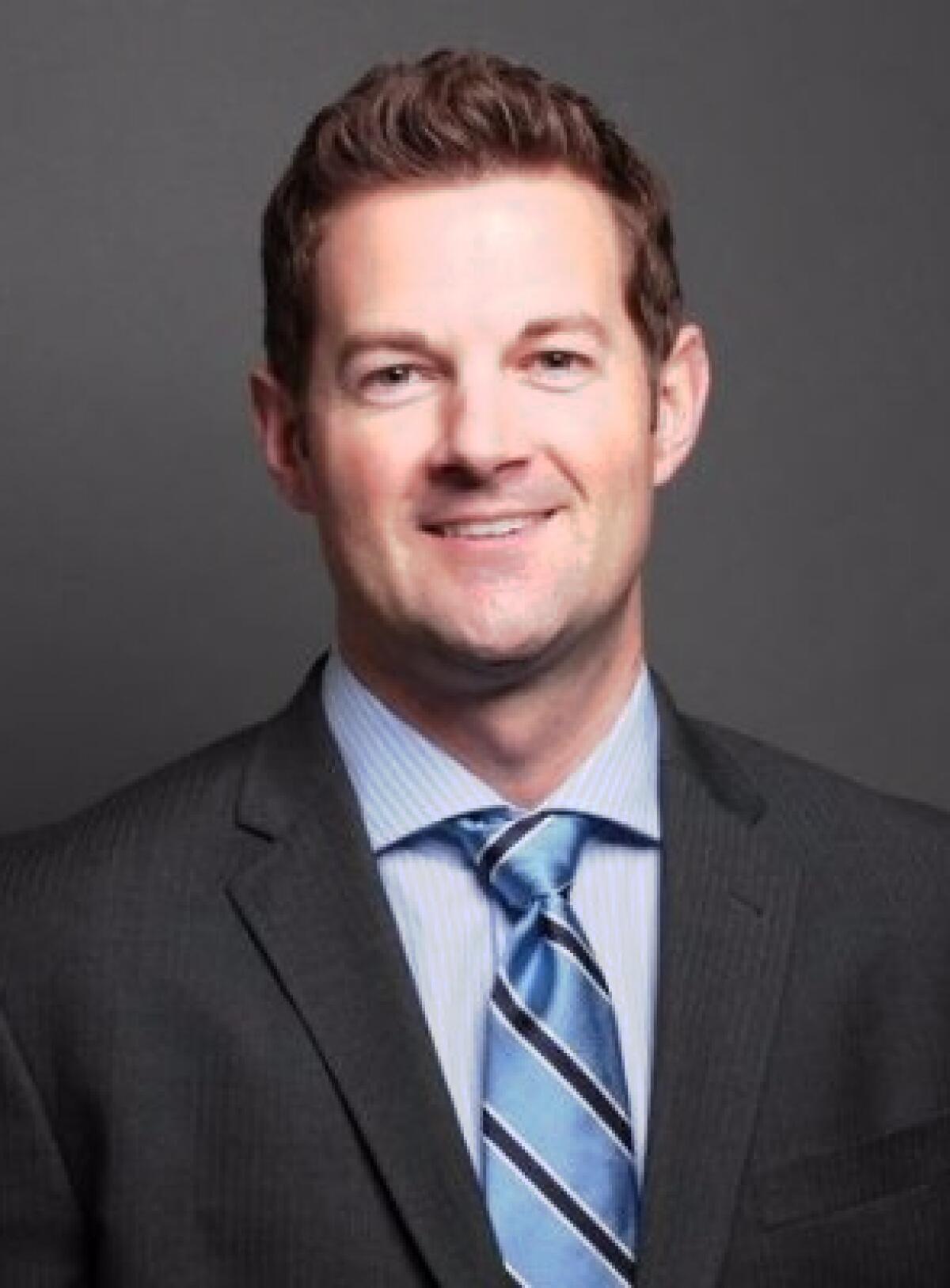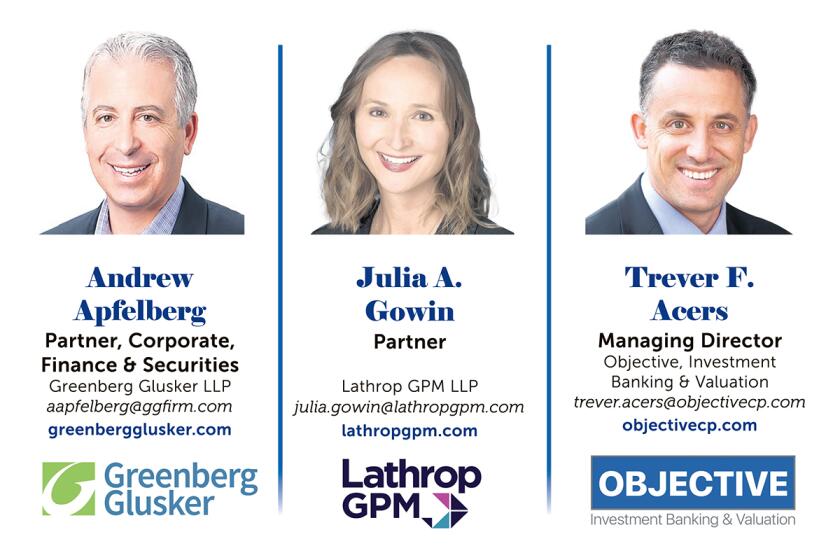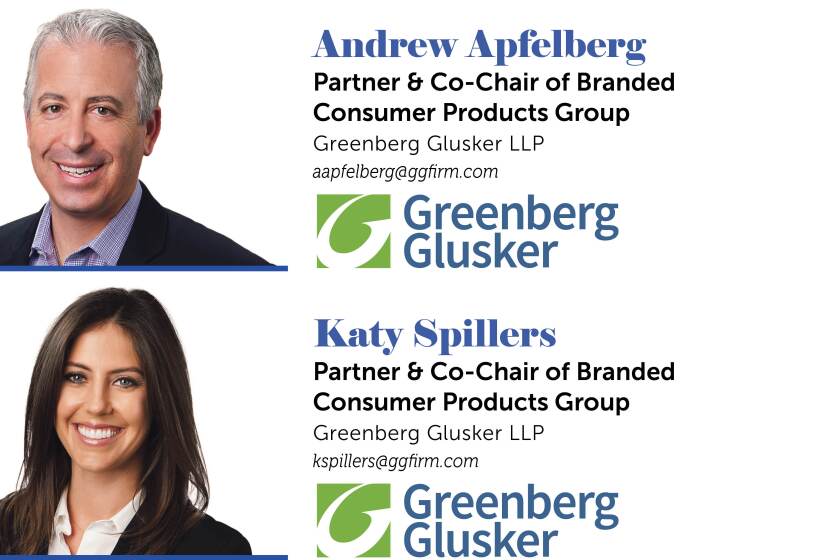Andrew Apfelberg and Brian Little, CFA, Share Insights on the Beauty, Fashion and Consumer Goods Industry
- Share via
The Beauty, Fashion & Consumer Goods ‘Conversation with the Experts’ section is produced by the L.A. Times B2B Publishing team in conjunction with Greenberg Glusker LLP and Kroll.
Many of the leading products and services behind keeping people living well while looking and feeling good are from businesses and organizations that were started and continue to thrive here in Los Angeles and the surrounding areas. In fact, successful beauty and self-care companies are catalysts for significant economic growth in the region.
Indeed, when it comes to the ever-evolving beauty, fashion and consumer goods industries, Southern California remains a prominent global leader in terms of trends, innovation, sustainability and protocols.
As the legal and financial landscapes around fashion, beauty and consumer products continue to adjust and shift, an increasing number of consumers, businesses and investors are tasked with navigating an often complex set of rules and best practices. As with any consumer-facing industry, learning about the ins and outs of the sector can be overwhelming.
To take a closer look at the latest developments and trends in the business of beauty, fashion and consumer goods, we have turned to two of the region’s leading authorities, who graciously weighed in for a discussion and shared insights.
Q: What are the pros and cons of being based in Los Angeles or Southern California in 2023?

Andrew Apfelberg, Partner, Corporate, Finance & Securities, Greenberg Glusker LLP: Let me start out by saying that the pros outweigh the cons. Some of the negatives include higher costs for employees and real estate as well as increased health and safety regulations as compared to companies located elsewhere. Being in a big city, there is also more competition, especially when first starting out and trying to find distribution and retail opportunities. Some of the positives, though, are the more open and accepting attitudes, willingness to try new things, and diverse tastes to accompany diverse backgrounds and lifestyles. Los Angeles attracts creative people who are willing to take risks. There is also the “Hollywood” factor that can be a huge opportunity to build brand awareness and loyalty.
Q: How would you describe the current outlook(s) for the beauty, fashion and consumer goods sectors in 2023?

Brian Little, CFA, Managing Director, Consumer M&A, Kroll: While the first half of 2023 was choppy from a macroeconomic point of view, the fashion/apparel sector has continued to perform well. Worries of a deep recession have subsided, and consumer spending has proven to be exceptionally resilient. The sector is expected to grow in 2023 (albeit at a slightly slower rate than in 2022), with outsized performance by both luxury brands on one end of the market and discounters on the other. We expect this barbell effect to flatten somewhat in 2024 as a reduction in inflation, supply chain disruption, and geopolitical instability should lead to a more stable economy.
Q: What are some of the biggest mistakes that consumer goods companies made during the pandemic?
Apfelberg: The biggest mistake made was getting so immersed in the day-to-day operations that companies lost focus on their current business plan and future goals, thus failing to take steps to best position themselves for the years to come. This was necessary during peak COVID times; survival was all that mattered. However, we are now on the tail end of that, and the changes it brought to what, how and where items are consumed are here to stay. I strongly recommend companies work “on the business” instead of “in the business” and convene a team of trusted advisors to provide their perspectives and guidance. Start the discussion with a description of where you want to be in three to five years so the target is clear. Then utilize all of the brainpower in the room to determine the optimal way or ways to get there.
Q: What is your projection for brick-and-mortar retail in the consumer goods space moving into the next few years?
Little: We believe there will be a sustained resurgence in brick-and-mortar retail for the foreseeable future. As costs have continued to rise for paid search and paid social, the margin profile for direct-to-consumer e-commerce brands has taken a significant hit. As a result, the cash outlay associated with owning your own retail (i.e. buildout costs, lease rates, etc.) is less expensive on a relative basis. Brick-and-mortar retail has also proven to be a great way to control the narrative around your brand, showcase your full product line, and initiate an authentic dialogue with your customer.
Los Angeles attracts creative people who are willing to take risks. There is also the “Hollywood” factor that can be a huge opportunity to build brand awareness and loyalty.
— Andrew Apfelberg
Q: How has social media changed the promotional landscape for the beauty and fashion world over the last decade?
Apfelberg: Influencer and social media marketing will be the leading edge of product promotion for the next handful of years. Consumers want a curated experience; especially from someone that they feel they can trust and admire. Whether or not it is, this feels more “authentic” than historical advertising. It also feels more “personal” in that the customer will only follow an influencer that resonates with them. Social media posts are powerful in that they can always be located (even ones from the past) with just a few clicks of a button and are attractive visually (and sometimes audibly, too). Combining this multi-sensory consumption of content with the “expertise” of the influencer creates an impactful and memorable impression on the consumer that can be (and often is) shared with friends and family, thereby creating a second endorsement for the product.
Q: What do investors look for in a health, beauty or consumer goods company these days?
Little: Despite a slowdown in M&A activity in the fashion/apparel sector during the first half of 2023, investors have generally been receptive to reviewing new deals entering the market. Although the appetite is there, however, we have found investors have been a bit more cautious with the opportunities they do pursue. The increase in the cost of capital – both debt and equity – has inevitably impacted investors’ expected returns, and this risk adjustment has ultimately put downward pressure on valuations. That said, fashion/apparel brands with a unique value proposition, consumer engagement, strong and demonstrable growth/margins and a backable management team will garner a “scarcity value” that is highly attractive to investors.
Apfelberg: There is no question that the market for financing and acquisitions has tightened or slowed. This makes obtaining growth capital or achieving a liquidity event for a business more difficult than in the past. To be able to achieve that, companies need to have products with an almost cult-like following, an experienced management team, a clearly articulated growth strategy and identifiable, concrete steps to achieve their business plan. There is a noticeable “flight to quality” when deals get evaluated. Companies need to do whatever it takes to put themselves into that category. We are seeing an increase in transactions for less than 50% of a company so that the founders/early investors can have a “second bite at the apple” in a few years when multiples and other deal terms are more seller-favorable. Transactions are also much more highly structured or complex than in the past. It is critical to understand the “real life” impact of all of this and “stress test” it under varying potential economic and operational future circumstances.
Worries of a deep recession have subsided, and consumer spending has proven to be exceptionally resilient.
— Brian Little, CFA
Q: What advice would you offer to an early‐stage beauty, fashion or consumer goods company seeking growth capital in 2023?
Little: Brands today need to be even more thoughtful about growth trajectory and the capital required to fund this expansion. Investors have become increasingly wary of unprofitable growth, and the idea of scaling into a large cost structure (the old “if you build it, they will come”) is all but gone. It’s also important to have cash on your balance sheet to capitalize on growth opportunities when they arise. From that perspective, taking VC/PE investment when it’s available has become increasingly important. As we’ve seen in the first half of 2023, growth capital is not always available.
Apfelberg: The best advice I can give is to think about where you want to end up and work backward from there. If your endgame is to sell one day, consider what potential purchasers want/don’t want and design your company accordingly. For instance, if they highly value ownership of IP, then it probably makes sense to pay more along the way and document things more formally to achieve this. If your valuation will be based on EBITDA (earnings before interest, taxes, depreciation and amortization), then you may want to run your business to maximize that instead of just growing revenue. If your endgame is to hand the company down to your kids or employees one day, give some thought to what those folks will need to know in order to carry on your legacy. Start training them now and include them in decision-making. Let them know your vision for the future and that you believe in them as the ones to implement it. Then, and only then, decide how much and what type of growth capital you want and the non-financial characteristics your investor should bring to the table. Make sure that the capital will enhance your chances of ending up in your desired place and negotiate the terms accordingly.
Brick-and-mortar retail has also proven to be a great way to control the narrative around your brand, showcase your full product line, and initiate an authentic dialogue with your customer.
— Brian Little, CFA
Q: What are consumers demanding from their products today that maybe they were not as concerned with in the past?
Apfelberg: We need to be realistic that our world has changed. We work from home, we don’t eat out as much and it takes a special set of circumstances for us to go out to crowded environments. This means that what we want is different. We more highly value comfort, health and something that looks good on Zoom. We want products that work with our less formal dress/look. It also means that how we want to get it is different. Going to a mall or brick-and-mortar store is less desirable than e-commerce. However, we still want to see how the product looks on us in particular and be able to inspect and interact with it as if it were truly in our hands. While we want it “now,” we are used to hearing about delays due to supply chain and staffing challenges. The beauty, fashion and consumer goods sectors have started adapting to this but will need to do so even more in the future.
Q: How do you view M&A within the fashion/apparel sector for 2023 and beyond?
Little: M&A for the sector slowed significantly in the first half of 2023, commensurate with the overall transaction market. This was driven partially by a resetting of valuations in the public market and further exacerbated by the broader macroeconomic volatility. M&A has rebounded in Q3, and valuations of public companies in the sector have continued to climb in 2023. We expect M&A activity to persist in 2024, with the first half of 2024 substantially outperforming the previous year. Brands with strong growth prospects and a healthy margin profile should continue to have exit options, both among strategic buyers and financial sponsors.
Influencer and social media marketing will be the leading edge of product promotion for the next handful of years.
— Andrew Apfelberg
Q: What advice would you offer to a mature beauty, fashion or consumer goods brand looking to go through a sale or merger in 2023?
Apfelberg: To prepare for a business exit within the next 12-18 months, it’s essential to do the following: review your insurance policies (e.g. general liability, directors and officers, product liability) with a broker to address potential post-deal liabilities; secure ownership of your formulas and intellectual property, such as trademarks; if not using an automated service, work with an accountant to manage sales tax collection and reporting; ensure all employee paperwork, including offer letters and arbitration agreements, is in order, and classify contractors correctly; update your privacy policy and terms of use to comply with California’s regulations; and verify that you have all necessary permits and consult with regulatory counsel if needed. Addressing these areas in advance will streamline the sale process and mitigate potential issues.

